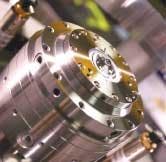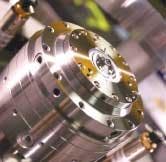"Immersion" was the word at the SPIE Microlithography 2004 meeting (Santa Clara, CA; Feb. 22–27) as chipmakers put off the tough climb to 157-nm optical lithography and opted instead for the slippery and wet descent to 45-nm and smaller feature sizes based on argon fluoride (ArF) 193-nm lithography technology. Two years ago, the semiconductor industry technology roadmap was still calling for fluorine (F2) 157-nm lithography to carry optical lithography down to its lowest possible resolution limits as early as next year; last year, however, the combination of dizzyingly high technology barriers and exponentially escalating costs was already causing the industry to push off estimated dates on the roadmap and to even consider alternate routes (see Laser Focus World, September 2003, p. 40).
The 4047 attendees at this year's meeting (compared to 3905 last year) set a new record; 1810 people attended the exhibits, and traffic on the semiconductor industry roadmap that attendees discussed at the meeting had definitely been rerouted from previous years. "Argon fluoride immersion is proving itself as a great idea," said Bob Akins, chief executive officer of Cymer (San Diego, CA). "This is the first tool in which initial performance was better than the estimates." Cymer has placed its F2 product-development plans on the back burner, he said, and has already introduced a second generation of its master oscillator power amplifier (MOPA) ArF lithography tool with 40 W of output power and narrow bandwidth targeted at the expected power requirements of high-numerical-aperture (NA) lenses for immersion systems. "Light sources may go up to 60 W or more for the high power needs of these exotic lenses," he said.
Corning Tropel (Fairport, NY) announced commercial availability of an immersion micro-objective lens assembly (see figure). An invited talk based on research at International Sematech (Austin, TX) and Motorola (Schaumburg, IL) was entitled "ArF: the final wavelength?" And the first annual Frits Zernike Award for Microlithography was presented to Burn Lin, senior director of the micropatterning technology division at TSMC (Hsinchu, Taiwan), whose list of major career achievements also happens to include early, strong, and active support of immersion lithography.
Replacing the air gap between the projection lens and the wafer with a fluid medium brings the index of refraction across the gap much closer to that of the lens, dramatically increasing the obtainable resolution and depth of field (the lens must be designed with the fluid's presence in mind). And while immersion is a long-standing and well-known optical technique for applications such as microscopy, it has only recently been applied to the semiconductor industry's quest for smaller and smaller feature sizes.
In a plenary talk on the limits of optical lithography, Chris Mack, vice president of lithography technology at KLA-Tencor (San Jose, CA), said that reducing the optical wavelength presents the most obvious method for writing smaller features, but it takes time. "The transition to 193 nm is still not in full swing," he said. "And the transition to 157 nm seems almost too challenging." The magnitude of change required for a wavelength reduction in the light source is, in fact, so great, he added, that the benefit to be achieved in terms of cost per square centimeter must be compelling—much greater than say, 10%.
Increasing NA beyond 1
Immersion lithography, on the other hand, offers a route to smaller feature sizes based largely on increasing the NA of the lens rather than taking on entirely new issues concerning resists, masks, pellicles, and optics that would be required for moving to a next-generation-lithography tool. Using immersion lithography with ultrapure water and indices of refraction on the order of 1.44, NAs of 1.2 and 1.3 might be reasonably achievable. Specially treated water may push the index up to 1.6 and enable NAs up to 1.4 or 1.5. Optical design and fabrication of such large-NA lenses remains nontrivial and very costly, but it can be done, Mack said.
For all of its potential advantages, however, immersion technology also adds complexity and issues to overcome. On the metrology side of the semiconductor house, for instance, bubbles in fluids must now be considered as defects; indices of refraction must be determined out to five decimal places; and chemical purity must be ascertained in parts per billion. Semiconductor metrology is currently in its fifth wave of development, according to keynote remarks given by Harry Levinson of Advanced Micro Devices (Sunnyvale, CA).
The first wave began in the mid-1970s with overlay pass-fail measurements when lithography processes consisted of contact and proximity printing of large feature sizes that eventually got down to about 5 µm. Today, however, the International Technology Roadmap for Semiconductors (ITRS) performance for controlling critical dimensions has accelerated by about 11 years beyond where it was expected to be about a decade ago. And the semiconductor industry is entering a fifth wave in which feature sizes are headed below the wavelength of light from 100 nm to about 40 nm, where computerized and automated metrology methods, such as scanning-electron microscopy and scatterometry, as well as Zernike methods for measuring aberrations, are being used and further refined.
Still many of the ITRS metrology targets from now through the end of this decade have "no known solution" listed as the proposed methodology, which may actually be less of an issue than the fact that line-edge-roughness requirements are also within that time approaching the realm of a few tenths of a nanometer (the same order as atomic-scale roughness). "At the scales we're talking about, no surfaces are going to be perfectly smooth," Levinson said. "New methods, such as x-rays, are being discussed, but what do the measurements mean at this level?"
Considerations such as these may have been what prompted Mack to open his talk by quoting Sturtevant's Law: "The end of optical lithography is always six or seven years away."

